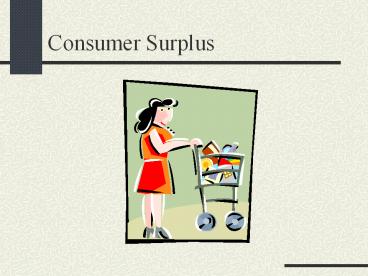Consumer Surplus - PowerPoint PPT Presentation
Title:
Consumer Surplus
Description:
3 ways of doing it: Compute changes in consumer's surplus; Compensating variation; ... much money we need to give the consumer after the price change to make him just ... – PowerPoint PPT presentation
Number of Views:660
Avg rating:3.0/5.0
Title: Consumer Surplus
1
Consumer Surplus
2
Demand Function and Demand Curve
- Demand function
- Demand Curve
3
Inverse Demand Function
- Consider a demand function
- The inverse demand function is
- Cobb-Douglas example
4
Inverse Demand Curve
- Inverse Demand Curve
- Optimal choice
- Suppose
- (composite good)
- Rearrange
5
Gross Consumer Surplus
- Consumer buys
- units of good 1.
- Consumer has different willingness to pay for
each extra unit. - GCS Area under demand curve.
- GCS tells us how much money consumer willing to
pay for
6
Consumer Surplus
- Consumer buys
- units of good 1.
- Consumer pays
- for each unit.
7
The Welfare Effect of Changes in Prices
- Goal provide a monetary measure of the effects
of price changes on the utility of the consumer. - 3 ways of doing it
- Compute changes in consumers surplus
- Compensating variation
- Equivalent variation.
8
Change in Consumers Surplus
- Suppose a tax increases price of good 1 from
- to .
- Decrease in CS
9
Change in Consumers Surplus
- In practice, to compute the change in CS we need
to have an estimate of the consumers demand
function. This can be done using statistical
methods. - How is change in CS related to change in utility?
The two coincide when utility is quasi-linear
10
Compensating Variation
- CVhow much money we need to give the consumer
after the price change to make him just as well
off as he was before the price change. - Budget line
11
Equivalent Variation
- EVhow much money we need to take away from the
consumer before the price change to make him just
as well off as he was after the price change. - Budget line
12
Compensating and Equivalent Variations
- To compute CV and EV we need to know utility
function of the consumer. - This can be estimated from the data by observing
consumers demand behavior. - E.g. observe consumers choices at different
prices and income levels. Observe that
expenditures shares are relatively constant - Cobb-Douglas preferences.
13
An Example Increase in Oil Prices
- Often, OPEC manages to restrict production and
significantly increase oil prices. - Whats the effect of this increase on consumers
welfare?
14
Model
- Consumers utility function over gasoline and
composite goods, - Moreover
15
Find Consumer Demands Before Price Increase
- Consumer solves
- Optimality condition
16
Find Consumer Demands Before Price Increase
- Since
- Demand for gasoline is
- Demand for composite good
-
17
Find Consumer Demands After Price Increase
- Since
- Demand for gasoline goes down
- Demand for composite good
-
18
Compute Change in Consumers Surplus
- Inverse demand function
- Consumer surplus
19
Compute Compensating Variation
- Government pays amount CV such that
- Plug in numbers
20
Compute Compensating Variation
- Plug in numbers
- Get
21
Compute Equivalent Variation
- Government pays amount EV such that
- Plug in numbers
22
Compute Equivalent Variation
- Plug in numbers
- Get
23
Conclusion
- In this case change in consumers surplus equals
compensating variation which equals equivalent
variation. - In general these three measures differ.
24
This Wednesday
- Who Wants to be an Economist?































